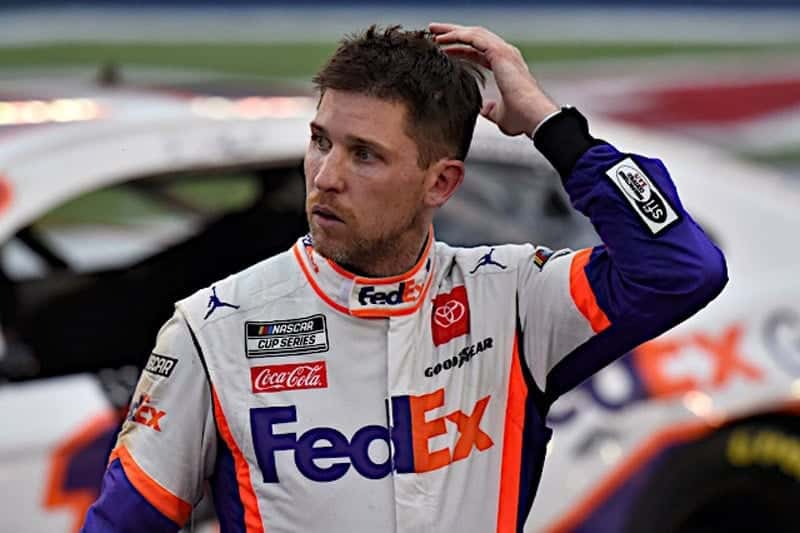
Imago
Denny-Hamlin’s Corey Heim respects Daniel Hemric

Imago
Denny-Hamlin’s Corey Heim respects Daniel Hemric
“I still think it’s 40 percent driver”. In 2012, Denny Hamlin, a driver with over a decade of experience, established a popular formula for NASCAR success: 40% driver, 40% car/team, and 20% luck. This formula was widely accepted, suggesting that a driver and their team held equal power, with a small but essential component of luck playing a role. After years of competing and experiencing near-misses, Hamlin has finally adjusted his formula.
Watch What’s Trending Now!
Despite his consistent performance and numerous victories, Denny Hamlin has yet to win a Cup Series championship. His near-misses can be attributed to a combination of factors, including bad luck, strategic errors, and strong teams/cars. The introduction of Next Gen cars in 2022 brought another major change in the parity within driving. According to the 58-time Cup Series winner, the competitive environment has transformed, and Hamlin is re-evaluating everything he once thought he knew about what it takes to win it all.
So what made him change his rating theory?
ADVERTISEMENT
Denny Hamlin reduces dependence on luck and favors driver capability
In a recent interview with The Athletic, Denny Hamlin reflected on how numerous factors contributing to success in NASCAR have shifted over time. Back in 2012, he believed winning a championship was 40 percent driver, 40 percent car and team, and 20 percent luck. Now, he initially suggested keeping the driver’s role at 40 percent and dividing the remaining breakdown equally to 30 percent car and 30 percent luck. The reason? “Cars aren’t quite as much of a factor because they’re more similar now, and luck because of the parity and since the cars all run the same speed,” he said. But he didn’t stick to this answer either.
Hamlin took this question home, which kept lingering in his mind, much after the interview ended. Two days later, when his brainstorming was over, Hamlin sent a note requesting to modify his initial assessment. His revised response said, “After thinking about it more, I believe these are the correct percentages in today’s world: Driver 65 percent, team 25 percent, luck 10 percent.”
ADVERTISEMENT
What made Hamlin increase the driver ability and reduce the luck factor so significantly? He explained, “I lowered luck because it’s not a factor in winning as much as being good is. It is still a factor in some wins, but great drivers have more opportunities to win because of their skill level. Team does matter, but with the Next Gen, you can’t build the difference in cars like you used to. The driver is the one who sends team in a direction to make the cars fast, thus being the most important.” Hamlin has thus rated the driver as the most important factor in a race’s success. Because the cars make the race monotonous, it’s the driver’s skill that sets him apart from the others. This is the reason he reduced the luck factor as the playground holds more or less the same luck conditions for all, including himself.
And speaking about the car factor, fans and drivers are not happy with the current Next Gen cars used in the Cup Series. They feel the cars make for boring races, especially on curvy tracks and smaller ovals. To explain what he meant, Hamlin talked about a recent race in a different series, the Xfinity Series, which uses the older versions that are faster. In that race, the cars were able to race closely together, and leaders couldn’t just pull away. This made the race more exciting because cars were constantly fighting for position. Hamlin suggested that the Next Gen cars prevent this kind of close, exciting racing, thereby reducing the value of cars and luck.
ADVERTISEMENT
Hamlin without a championship yet shares his updated view on retirement
Denny Hamlin, a four-time winner in the 2025 NASCAR season, is defying expectations at 44 years old. While he is one of the grid’s most veteran drivers, his performance has only improved with age. During a recent interview with motorsports journalist Jeff Gluck for his popular ’12 Questions’ series, Hamlin reflected on how his perspective on retirement has changed.
In a similar conversation back in 2010, a younger Hamlin had a very different outlook. At the time, he predicted he would stop racing around age 37 or 38, stating, “There’s too much outside of racing to do this until I’m 50 or whatever.” He also believed that if he were to race for 10 straight years, that would be his limit. Fast forward to 2025, and Hamlin’s actions speak louder than his past predictions.
ADVERTISEMENT
Having just signed a new two-year contract extension with Joe Gibbs Racing, he was asked by Gluck about his updated timeline. Hamlin has now commented on his own past statement on retiring at a certain age with “I’m clearly not good at predicting.” This simple statement highlights his shift from a rigid timeline to a more fluid, performance-based approach to his career. His continued success suggests that as long as he’s winning, he’ll keep racing, and hopefully hang his boots after ultimately getting home a championship title.
ADVERTISEMENT
ADVERTISEMENT
ADVERTISEMENT

